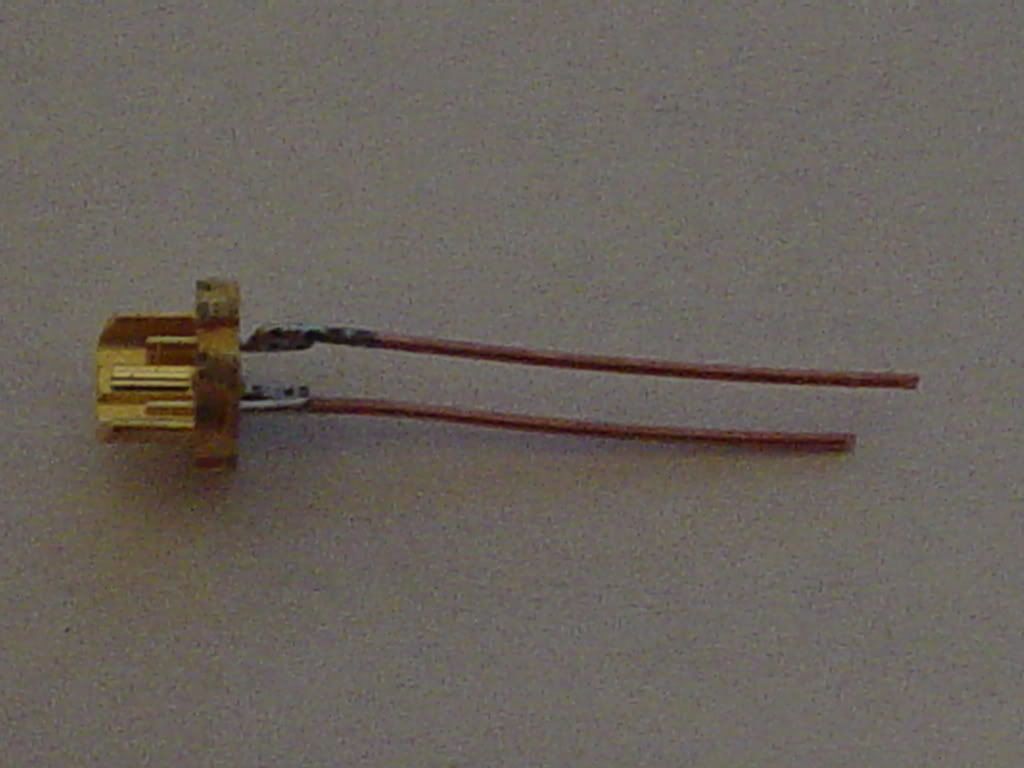- Joined
- Apr 12, 2008
- Messages
- 15
- Points
- 0
Well I rigged up your standard do it yourself driver on a breadboard with parts identical to the one in the video from Phazonx in that other post. Another diagram I found elsewhere recommended a 4ohm resistor and his recommended two 10's in parallel for a 5 ohm resistance so I just went with dual 10s cuz I couldn't find a 4  So I turned the 25 ohm potentiometer down to absolute maximum resistance. I tested it and it's 25.0 ohms exactly and on minimum, it's basically 0 ohms. I'm using 4 brand new D batteries that measured at 6.51V total and as I turn it up and down, the output voltage stays steady at 5.90V. From minimum to maximum on the pot I get an output of 4 and around 220 milliamps. So it seems to working properly. Now just to make sure, the laser diode I'm testing with is a 650nm 5mw one that specifically says run it at 3.2V. So sending 5.9 volts normally would fry it but since I'm limiting the current, it won't fry and it's all good, right?
So I turned the 25 ohm potentiometer down to absolute maximum resistance. I tested it and it's 25.0 ohms exactly and on minimum, it's basically 0 ohms. I'm using 4 brand new D batteries that measured at 6.51V total and as I turn it up and down, the output voltage stays steady at 5.90V. From minimum to maximum on the pot I get an output of 4 and around 220 milliamps. So it seems to working properly. Now just to make sure, the laser diode I'm testing with is a 650nm 5mw one that specifically says run it at 3.2V. So sending 5.9 volts normally would fry it but since I'm limiting the current, it won't fry and it's all good, right?
Well here's the "problem." The instructions in the video say to turn the pot all the way down and then connect the LD then connect the power source. Then you're supposed to turn the pot up until the diode starts emitting light. Well my diode turns on even at maximum resistance and it looked pretty bright too. According to my earlier measurement it's only sending 4 milliamps under those conditions. The kinda sketchy stats on mfgcn say operating current is 40ma. So it's seriously running on 4? Is that normal? In fact I pulled one of the 10 ohm resistors so it was double the resistance at 10 ohms and that only brought it down to 3 ma and it still ran the LD. What's up with that?
So assuming it can run on extremely low current, that runs into another problem. When turned all the way up, it sends 220ma which is probably enough to fry the 5 mw LD. But eventually I'm swapping out the diode with a 200+ mw laser diode from a 20x DVD burner. First of all, will that one turn on with just 4 millamps too? And second, if I want that sucker to pop a balloon and such, I'll need it running near max power, right? So I have to turn it up manually until it's near it's max operating current. So that brings us to the big question: how many millamps should a DVD burner diode safely run at?
Well here's the "problem." The instructions in the video say to turn the pot all the way down and then connect the LD then connect the power source. Then you're supposed to turn the pot up until the diode starts emitting light. Well my diode turns on even at maximum resistance and it looked pretty bright too. According to my earlier measurement it's only sending 4 milliamps under those conditions. The kinda sketchy stats on mfgcn say operating current is 40ma. So it's seriously running on 4? Is that normal? In fact I pulled one of the 10 ohm resistors so it was double the resistance at 10 ohms and that only brought it down to 3 ma and it still ran the LD. What's up with that?
So assuming it can run on extremely low current, that runs into another problem. When turned all the way up, it sends 220ma which is probably enough to fry the 5 mw LD. But eventually I'm swapping out the diode with a 200+ mw laser diode from a 20x DVD burner. First of all, will that one turn on with just 4 millamps too? And second, if I want that sucker to pop a balloon and such, I'll need it running near max power, right? So I have to turn it up manually until it's near it's max operating current. So that brings us to the big question: how many millamps should a DVD burner diode safely run at?






